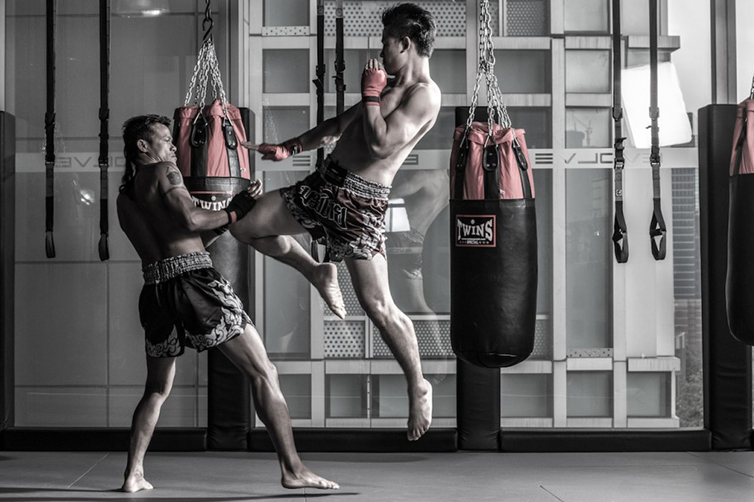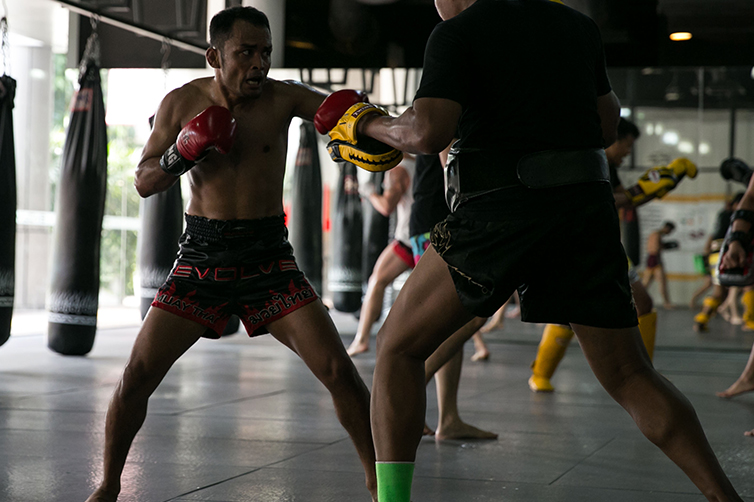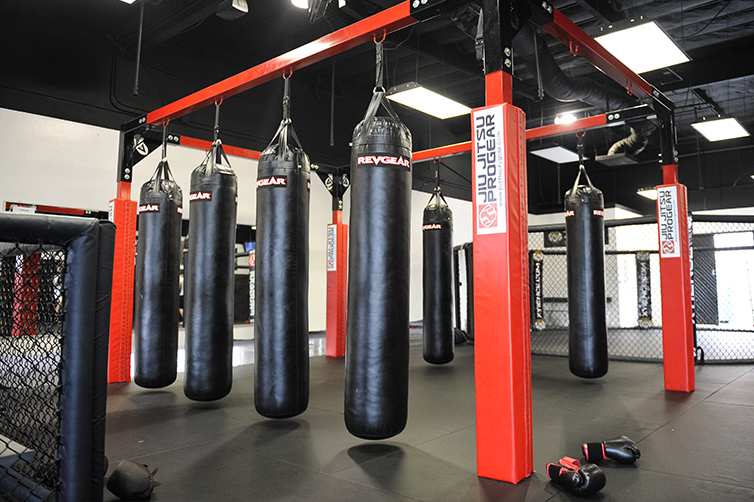Brazilian jiu-jitsu (//; Portuguese: [ˈʒiw ˈʒitsu], [ˈʒu ˈʒitsu], [dʒiˈu dʒiˈtsu]) (BJJ) is a grappling art, combat sport, and a self defense system that focuses on grappling and especially ground fighting. Brazilian jiu-jitsu was formed from Kodokan Judo ground fighting (Ne-Waza) fundamentals that were taught to Carlos Gracie by master Mitsuyo Maeda. Brazilian jiu-jitsu eventually came to be its own art through the experimentations, practices, and adaptation from the Judo knowledge of Carlos and Helio Gracie, who then passed their knowledge onto their family.
BJJ promotes the concept that a smaller, weaker person can successfully defend against a bigger, stronger assailant by using leverage and proper technique, taking the fight to the ground – most notably by applying joint-locks and chokeholds to defeat the other person. BJJ training can be used for sport grappling tournaments (gi and no-gi) and mixed martial arts (MMA) competition or self-defense. Sparring(commonly referred to as "rolling") and live drilling play a major role in training, and a premium is placed on performance, especially in competition, in relation to progress and ascension through its ranking system.
Since its inception in 1914, its parent art of Judo was separated from older systems of Japanese ju-jitsu by an important difference that was passed on to Brazilian jiu-jitsu: it is not solely a martial art: it is also a sport; a method for promoting physical fitness and building character in young people; and, ultimately, a way (Do) of life.[
Muay Thai (Thai: มวยไทย, RTGS: Muai Thai, is a combat sport from the muay martial arts of Thailand that uses stand-up striking along with various clinching techniques. This physical and mental discipline which includes combat on foot is known as "the art of eight limbs" because it is characterized by the combined use of fists, elbows, knees, shins and feet, being associated with a good physical preparation that makes a full-contact fighter very efficient. Muay Thai became widespread internationally in the twentieth century, when practitioners defeated notable practitioners of other martial arts. A professional league is governed by the World Muay Thai Council.
Muay boran, and therefore Muay Thai, was originally called by more generic names such as pahuyuth (from the Sanskrit bahu-yuddha meaning unarmed combat), Toi muay or simply muay. As well as being a practical fighting technique for use in actual warfare, muay became a sport in which the opponents fought in front of spectators who went to watch for entertainment. These muay contests gradually became an integral part of local festivals and celebrations, especially those held at temples. Eventually, the previously bare-fisted fighters started wearing lengths of hemp rope around their hands and forearms. This type of match was called muay khat chueak (มวยคาดเชือก). Kickboxing was also a component of military training and gained prominence during the reign of King Naresuan in 1560 CE.
Muay Thai is referred to as the "Art of Eight Limbs" or the "Science of Eight Limbs", because it makes use of punches, kicks, elbows and knee strikes, thus using eight "points of contact", as opposed to "two points" (fists) in boxing and "four points" (hands and feet) used in other more regulated combat sports, such as kickboxing and savate. A practitioner of muay Thai is known as a nak muay. Western practitioners are sometimes called Nak Muay Farang, meaning "foreign boxer."
Mixed martial arts (MMA) is a full contact combat sport that allows the use of both striking and grappling techniques, both standing and on the ground, from a variety of other combat sports. Various mixed style contests took place throughout Europe, Japan and the Pacific Rim during the early 1900s. The combat sport of vale tudo that had developed in Brazil from the 1920s was brought to the United States by the Gracie family in 1993 with the founding of the Ultimate Fighting Championship (UFC).
The more dangerous vale-tudo-style bouts of the early UFCs were made safer with the implementation of additional rules, leading to the popular regulated form of MMA seen today. Originally promoted as a competition with the intention of finding the most effective martial arts for real unarmed combat situations, competitors were pitted against one another with minimal rules. Later, fighters employed multiple martial arts into their style while promoters adoptedadditional rules aimed at increasing safety for competitors and to promote mainstream acceptance of the sport. The name mixed martial arts was coined by television critic Howard Rosenberg, in 1993, in his review of UFC 1. The term gained popularity when the website newfullcontact.com, then one of the biggest covering the sport, hosted and reprinted the article. Following these changes, the sport has seen increased popularity with a pay-per-view business that rivals boxing and professional wrestling.
Boxing (pugilism, prize fighting, the sweet science or in Greek pygmachia) is a combat sport in which two people engage in a contest of strength, speed, reflexes, endurance, and will by throwing punches with gloved hands against each other.
Amateur boxing is an Olympic and Commonwealth sport and is a common fixture in most of the major international games—it also has its own World Championships. Boxing is supervised by a referee over a series of one- to three-minute intervals called rounds. The result is decided when an opponent is deemed incapable to continue by a referee, is disqualified for breaking a rule, resigns by throwing in a towel, or is pronounced the winner or loser based on the judges' scorecards at the end of the contest.
The origin of boxing may be its acceptance by the ancient Greeks as an Olympic game in BCE 688. Boxing evolved from 16th- and 18th-century prizefights, largely in Great Britain, to the forerunner of modern boxing in the mid-19th century, again initially in Great Britain and later in the United States.
Submission wrestling (also known as submission fighting, submission grappling, sport grappling, or simply as No-Gi) orCombat wrestling (in Japan), is a formula of competition and a general term for martial arts and combat sports that focus onclinch and ground fighting with the aim of obtaining a submission using submission holds. The term "submission wrestling" usually refers only to the form of competition and training that does not use a "jacket", "gi," or "combat kimono," often worn with belts that establish rank by color.
The sport of submission wrestling brings together techniques from Folk Wrestling (Catch-as-catch-can), Luta Livre Esportiva,Judo, Freestyle Wrestling, Brazilian Jiu-Jitsu, Ju-Jitsu and Sambo. Submission fighting as an element of a larger sport setting is very common in mixed martial arts, Pankration, catch wrestling and others. Submission wrestlers or grapplers usually wear shorts, skin-sticky clothing such as Rash guards, speedos and mixed short clothes so they do not rip off in combat. They are also known for using submission techniques normally banned in other arts or competitions such as heel hooks, toe holds, wrist and finger locks.
Wrestling is a combat sport involving grappling type techniques such as clinch fighting, throws and takedowns, joint locks, pins and other grappling holds. A wrestling bout is a physical competition, between two (occasionally more) competitors or sparring partners, who attempt to gain and maintain a superior position. There are a wide range of styles with varying rules with both traditional historic and modern styles. Wrestling techniques have been incorporated into other martial arts as well as military hand-to-hand combat systems. Kickboxing is a group of stand-up combat sports based on kicking and punching, historically developed from Karate, Muay Thai, and Western boxing. Kickboxing is practiced for self-defense, general fitness, or as a contact sport.
Japanese kickboxing originated in the 1960s, with competitions held since then. American kickboxing originated in the 1970s and was brought to prominence in September 1974, when the Professional Karate Association (PKA) held the first World Championships. Historically, kickboxing can be considered a hybrid martial art formed from the combination of elements of various traditional styles. This approach became increasingly popular since the 1970s, and since the 1990s, kickboxing has contributed to the emergence of mixed martial arts via further hybridization with ground fighting techniques from Brazilian jiu-jitsu and Folk wrestling.
There is no single international governing body. International governing bodies include International Combat Organisation, World Association of Kickboxing Organizations, World Kickboxing Association, International Sport Karate Association, International Kickboxing Federation, World Sport Kickboxing Federation, among others. Consequently, there is no single kickboxing world championship, and champion titles are issued by individual promotions, such as K-1, Glory, SUPERKOMBAT, Lumpinee Boxing Stadium, among others. Bouts organized under different governing bodies apply different rules, such as allowing the use of knees or clinching, etc.
Self-defense (self-defence in British spelling) is a countermeasure that involves defending the health and well-being of oneself, or of another, from harm.[1] The use of the right of self-defense as a legal justification for the use of force in times of danger is available in many jurisdictions, but the interpretation varies widely. 





















